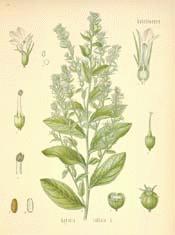

|
Indian-tobacco
(Lobelia inflata LINN.)
|
Lobelia
Botanical: Lobelia inflata (LINN.)
Family: N.O. Lobeliaceae
---Synonyms---Rapuntium inflatum. Indian-Tobacco. Pukeweed. Asthma Weed. Gagroot. Vomitwort. Bladderpod. Eyebright.
---Parts Used---The dried flowering herb, and seeds.
---Habitat---Dry places in the northern United States, Canada and Kamchatka. Grown in English gardens.
---Description---The herb is named after the botanist Matthias de Lobel, a native of Lille, who died in London in 1616. It is an erect annual or biennial herb, 1 to 2 feet high; lower leaves and also flower are stalked, the latter being pale violet-blue in colour, tinted pale yellow within. Commercially, it is usually prepared in compressed, oblong packages, by the Shakers of New Lebanon for importation into England. The colour is a yellowish green, the odour irritating, the taste, after chewing, very like that of tobacco, burning and acrid, causing a flow of saliva. The powder has a greenish colour, but that of the seeds is brown, and stains paper with grease.
Several species are cultivated in English gardens for the splendour of their flowers, in every shade of scarlet, purple, and blue. Lobelia Dortmanna and L. Urens are British. The fixed oil, with constituents rather like that of linseed oil, possesses the drying qualities common to the fixed oils together with all the medicinal properties of the seed.
The plant was known to the Penobscot Indians and was widely used in New England long before the time of Samuel Thomson, who is credited with its discovery. It was brought into general professional use by Cutler of Massachusetts.
---Constituents---The activity of Lobelia is dependent upon a liquid alkaloid first isolated by Proctor in 1838 and named Lobeline. Pereira found a peculiar acid which he named Lobelic acid. Also, gum, resin, chlorophyl, fixed oil, lignin, salts of lime and potassium, with ferric oxide. Lobelacrine, formerly considered to be the acrid principle, is probably lobelate of lobeline. The seeds contain a much higher percentage of lobeline than the rest of the plant.
[Top]
---Medicinal Action and Uses---Expectorant, diaphoretic, anti-asthmatic. It should not be employed as an emetic. (Herbalists, who use lobelia far more than the ordinary practitioners, nearly always prescribe it in doses large enough to prove emetic, and regard it as of greater value thus used. - EDITOR.) Some authorities attach great value to it as an expectorant in bronchitis, others as a valuable counterirritant when combined with other ingredients in ointment form. It is sometimes given in convulsive and inflammatory disorders such as epilepsy, tetanus, diphtheria and tonsilitis. There is also difference of opinion with regard to its narcotic properties. Where relaxation of the system is required, as, for instance, to subdue spasm, Lobelia is invaluable. Relaxation can be counteracted by the stimulating and tonic infusion of capsicum. It may be used as an enema.
Externally, an infusion has been found useful in ophthalmia, and the tincture can be used as a local application for sprains, bruises, or skin diseases, alone, or in powder combined with an equal part of slippery elm bark and weak lye-water in a poultice. The oil of Lobelia is valuable in tetanus. One drop of oil triturated with one scruple of sugar, and divided into from 6 to 12 doses, is useful as an expectorant, nauseant, sedative, and diaphoretic, when given every one or two hours.
---Preparations and Dosages---Powdered bark, 5 to 60 grains. Fluid extract, 10 to 20 drops. Acid tincture, 1 to 4 drachms. Tincture, U.S.P., 1 to 4 drachms. Etherial tincture, B.P., 5 to 15 drops. Syrup, 1 to 4 drachms. Solid extract, 2 to 4 grains. Oil of seed, 1 drop rubbed up with 20 grains of ginger and divided into 6 to 12 doses. Lobelin, 1/4 to 3 grains.
Acetum Lobellae (Vinegar of Lobelia). Lobelia seed powder, 4 OZ. Diluted acetic acid, 2 pints. Macerate in a close glass vessel for seven days, then express the liquor, filter, and add to the filtered product alcohol, or concentrated acetic acid, 1 fluid ounce. The whole should measure 2 pints. This medicated vinegar may also be prepared by percolation. It is an emetic, nauseant, and expectorant, and a valuable relaxant in spasmodic affections. A good application in such skin diseases as salt-rheum, erysipelas, poisoning by rhus, etc. As an expectorant, 5 to 30 drops every half-hour in elm or flaxseed infusion. One part of Vinegar of Lobelia to 1 part of syrup forms a pleasant preparation for children.
[Top]
---Poisonous, if any, with Antidotes---In excessive doses the effects are those of apowerful acro-narcotic poison, producing great depression, nausea, cold-sweats, and possibly death. (Herbalists also deny that it has poisonous properties and that it has ever caused death. - EDITOR.) Poisonous symptoms may occur from absorption of it through the epidermis.
---Other Species---
L. Dortmanna. This is indigenous toGreat Britain, and is rather similar in action to L. inflata. A tincture of the fresh plant cures headaches and noises in the ears.
L. Erinus. A tincture of the plant has been used in cancer and has produced absolute freedom from pain; is also used as a remedy in syphilis.
LOBELIA, BLUE (L. Syphilitica) and LOBELIA RED (L. Cardinalia). Both used in homeopathy. The first is diaphoretic, emetic and cathartic and has been used in dropsy, diarrhoea, syphilis and dysentery, the root being the part used. The Red Lobelia is said to be anthelmintic, nervine and antispasmodic.
L. Kalmit. Said to be used by the Indians in the cure of syphilis.
L. purpurascens. A tincture of the whole plant is used in paralysis of the lungs and tongue.
[Top]
Common Name Index
A MODERN HERBAL Home Page
Purchase this Herb from Botanical.com
Bear in mind "A Modern Herbal" was written with the conventional wisdom of the early 1900's. This should be taken into account as some of the information may now be considered inaccurate, or not in accordance with modern medicine.
© Copyright Protected 1995-2004 botanical.com

|

